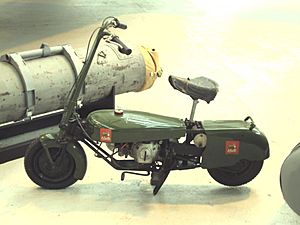Welbike facts for kids
 |
|
| Manufacturer | Excelsior Motor Company of Birmingham |
|---|---|
| Production | 1942–1945 |
| Successor | Corgi 50 |
| Engine | 98 cc (6.0 cu in), two-stroke, air cooled, single |
| Transmission | Single-speed |
| Suspension | None |
| Weight | 32 kg (71 lb) (dry) |
| Fuel capacity | 3.7 litres (0.81 imp gal; 0.98 US gal) |
The Welbike was a special folding motorcycle made in Britain during World War II. It was designed for secret agents and paratroopers. This tiny bike holds the record for being the smallest motorcycle ever used by the British military!
Between 1942 and 1943, over 3,600 Welbikes were built. They were used by British airborne divisions, like the ones at Arnhem during Operation Market Garden. Other countries, such as Italy, Germany, and the United States, also created small motorcycles for their airborne forces during the war.
Contents
How the Welbike Was Developed
The idea for the Welbike came from John Dolphin, a military officer. The first design was created by Harry Lester, who loved motorcycles. They worked at a secret research place called Station IX in Welwyn, UK.
The Welbike was powered by a small 98 cm3 (6.0 cu in) two-stroke engine. It was designed to fit into a special container called a CLE Canister. This container was 51 inches (130 cm) long, 15 inches (38 cm) high, and 12 inches (30 cm) wide. It could be dropped from an airplane by parachute.
The name Welbike came from the town Welwyn. All secret equipment made at Station IX had names starting with Wel, like the Welman and Welrod.
Because it had to fit into a small container, the Welbike was very simple. It had no suspension (so it was a bumpy ride!), no lights, and only one brake on the back wheel. The fuel tank was also tiny. It needed a hand pump to push fuel to the engine because the tank was lower than the engine. A full tank could let it travel about 90 miles (140 km) at 30 mph (48 km/h).
When the Welbike landed, paratroopers could quickly get it ready. They just had to twist the handlebars, pull up the seat, and fold out the footrests. The goal was for a soldier to get the bike out of its container and be ready to ride in just 11 seconds!
The first Welbike design was sent to Excelsior Ltd for more improvements. Early tests showed the engine wasn't powerful enough for a soldier with all their gear. So, the engine was adjusted to give it more power.
The Welbike's simple design made it quick to produce. It was used by airborne forces, and later by ground troops like the Commandos and Royal Marines. Its small size also made it useful for the Royal Air Force on large airfields, especially in the Far East.
There were three main versions of the Welbike:
- Mark 1: The first 1,200 bikes. They had tuned engines and no rear mudguard.
- Mark 2 Series 1: About 1,400 bikes with small changes, including a rear mudguard.
- Mark 2 Series 2: The last batch of bikes. They had improved fuel tanks and a better filler cap.
Even though it was clever, the Welbike had some problems in combat. Paratroopers needed to find their bike's container after landing, which could be hard if it landed far away. Sometimes, bikes were lost or captured by the enemy before they could be used. Also, the small wheels and low power made it hard to ride on rough battlefields. Soldiers often left them behind and continued on foot. As the war went on, larger gliders were developed that could carry bigger, more powerful motorcycles, making the Welbike less necessary.
Production Numbers
Many Welbikes were made during World War II. After the war, many were sold, especially in the United States.
The Corgi Scooter
After the war, John Dolphin used his ideas from the Welbike to create a new scooter called the Corgi. It was made by Brockhouse Engineering. The Corgi scooter started production in 1947. Many were first sold in North America as the "Indian Papoose."
The Corgi had a single-speed two-stroke engine. It was quite slow and had some reliability issues. Even with a high demand for transport after the war, production stopped in 1954.
While some Corgi scooters were painted military green, they weren't widely used by the British armed forces. However, the idea of a folding motorcycle continued to inspire others, leading to bikes like the Honda Monkey bike in the 1960s.
Where to See Welbikes Today
Welbikes are quite rare now, but some still exist in museums and private collections around the world. You can find them in the UK, US, Canada, Australia, South Africa, and other countries.
Some places where you might see a Welbike include:
- RAF Harrington Aviation Museum in Harrington, UK
- South African National Museum of Military History in Johannesburg, South Africa
- Imperial War Museum in the UK
- Musée de l'Armée in France
- National Motor Museum, Beaulieu in the UK
Images for kids



